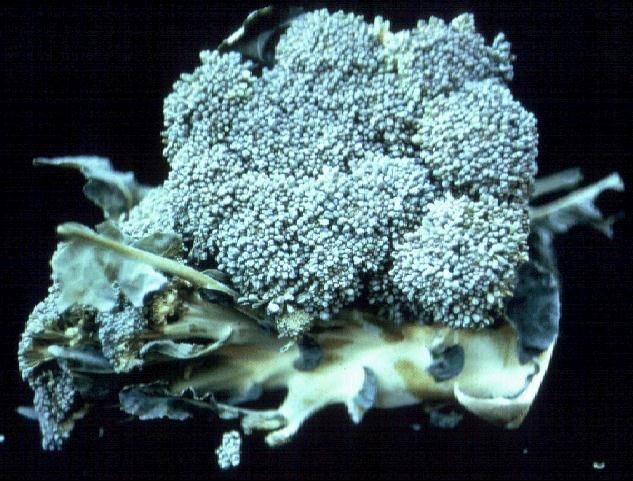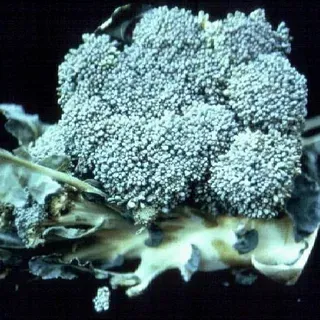Broccoli—Brassica oleracea L. (Italica group)1
Broccoli is closely related to cauliflower since both are grown for the clusters of unopened flower buds and tender flower stalks. The Italian word brocco means sprout, bud, or shoot, from the Latin brachium meaning an arm or branch.
Description
Broccoli has two different distinct forms. One is sprouting broccoli, which makes a somewhat branching cluster of green flower buds atop a thick, green flower stalk, and smaller clusters that arise like sprouts from the stems. This form, called calabrese in Britain, is the most commonly grown form in the United States. The other type of broccoli makes a dense, white curd like that of cauliflower and is called heading broccoli or cauliflower broccoli. This latter form is usually grouped with cauliflower, leaving the term broccoli restricted to sprouting varieties.

Credit: James M. Stephens
Like the other close relatives of cabbage, broccoli is native to the Mediterranean area and Asia Minor. It has been popular in Italy since the days of the Roman Empire. However, records indicate this vegetable was unknown in England until a relatively recent few hundred years ago. It has become popular in the United States only during this century.
Culture
Broccoli is grown in about 15% of United States gardens, according to a national survey. In Florida, broccoli is probably grown to a slightly greater extent than in other areas of the country, comparing favorably with beets and garden peas in frequency of production. However, all three of these vegetables must compete with such cooking greens as collards, turnips, and mustard for space in the garden.
Broccoli is well-adapted to all areas of the state when grown during the coolest months of the year. Plant in the north and central districts of Florida no earlier than mid-August and continue through mid-March. In South Florida, plant September through January.
Although broccoli is a cool season vegetable, it is susceptible to cold injury, especially when the plants are tender and not conditioned to withstand low temperatures. Temperatures of 26°F–32°F for 30 to 36 hours have killed broccoli plants in some previous years in north Florida. Temperatures in the 30s for 20 or more days may have a severe stunting effect on broccoli. Plants stunted by low temperatures form small central flower buds and very few side shoots. To avoid loss from freezing, plant in February or early March.
Varieties of broccoli vary considerably in garden performance. The old standard 'Waltham 29' still is a top choice. It is ready to cut from 80 to 100 days from transplanting and continues to form side shoots (secondary heads) after the main central head is cut.
Other varieties for Florida gardeners are 'Green Mountain,' 'Spartan Early,' 'Atlantic,' 'Green Sprouting,' 'Green Comet,' 'Italian Green Sprouting,' 'DeCicco,' 'Green Duke,' and 'Packman.' Cauli-broc has the tender texture and sweet flavor of broccoli, but has a lime-green head similar to cauliflower.
Soil preparation, bedding, liming, fertilization, and irrigation practices are similar to those for cabbage and collards. Since direct seeding may result in poor stands, start broccoli by using healthy, vigorous 4- to 5-week-old transplants. Set plants 18 to 24 inches apart on rows that are 36 to 40 inches wide. Watch for cabbage loopers and imported cabbage worms, which are especially troublesome on broccoli.
Harvesting
The central head should be harvested first when it is still tight and compact, with no opened flowers. It takes from 60 to 100 days from planting to first harvest. As much as 5 inches of the flower stalks should be cut along with the buds. Do not allow the stems to become tough and woody. After the central head is removed, side shoots will develop. Although smaller, these should be harvested at 2- to 4-day intervals. The entire harvest period may run from 40 to 80 days, depending on the season, crop condition, and locality.



